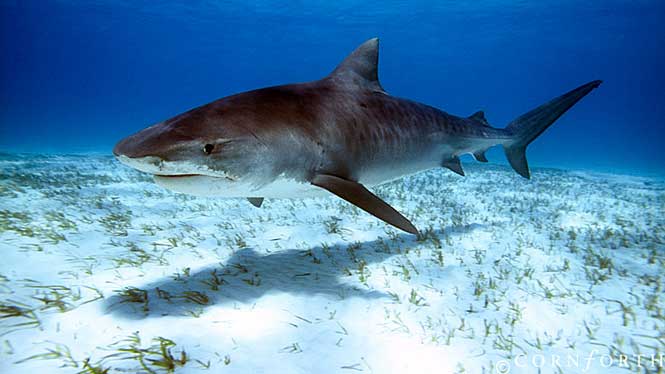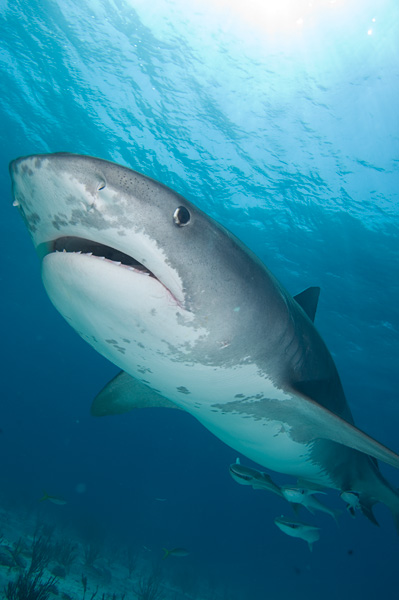Source (google.com.pk)

Images Of Tiger Sharks Biography
Description
Kingdom Animalia
Phylum Chordata
Class Chondrichthyes
Order Carcharhiniformes
Family Carcharhinidae
Genus Galeocerdo (1)
One of the largest sharks in the world, the tiger shark (Galeocerdo cuvier) is named for the characteristic, vertical striped markings that run along the length of its body (2) (4). These markings are most pronounced in juvenile tiger sharks, but fade with age, being generally absent in adults of over three metres in length (5). In overall colouration, the adult tiger shark is bluish-green to dark grey above, and yellowish-white to stark white below. The body shape is distinctive, with a broad head and upper body, becoming increasingly slender towards the tail. As expected of such a formidable predator, the jaws of the tiger shark are large and house a set of sizeable teeth with curved cusps and finely serrated edges (4).
Size
Average length: 3.3 to 4.3 m (2)
Maximum length: 7.5 m (3)
Biology
Renowned for its voracious appetite and indiscriminate feeding habits, the tiger shark has been known to consume an incredible array of items, from standard prey such as fish, turtles and marine mammals, to human rubbish, including burlap sacks and car license plates (4) (5). Such behaviour enables this species to overcome the problem of food shortages, which can affect sharks that feed more selectively (2). Unfortunately, the tiger shark’s curiosity and tendency to sample such a wide variety of objects has meant that on occasion it has been responsible for attacks on humans. As a result of its large size, tiger shark attacks can be fatal, but in spite of a great deal of media hype, they are extremely rare (4) (6). A solitary species, the tiger shark usually feeds at night, moving to inshore locations where it engages in active hunting of prey, as well as scavenging, before returning to deeper waters where it spends the day (4). Home ranges appear to be very large, with electronically tagged tiger sharks released in Hawaii swimming over 16 kilometres within a day of being released, and taking between two weeks and nine months to revisit the release area (2).
Tiger sharks are ovoviviparous, which means that after fertilisation, the embryos develop within the female’s uterus, receiving nourishment from a yolk sac. Once the yolk sac nutrients are exhausted the embryos are thought to gain further nourishment from secretions produced by the uterus until birth takes place. The gestation period—from egg fertilisation to birth— takes between 14 and 16 months, with births taking place in the Northern Hemisphere between April and June, and in the Southern Hemisphere from November to January (4). Litter sizes vary between 10 and 82 pups, with the newborns measuring between 0.5 and 1.05 metres (2).
Range
A common species, the tiger shark can be found worldwide in tropical and warm-temperate waters (1) (4). While there have been reports of this species as far north as Iceland and the United Kingdom, they are likely to be roaming individuals following the warm Gulf Stream north across the Atlantic. Tiger sharks undergo a seasonal migration, moving from the tropics into temperate waters during the warmer months and returning in the winter (4).
Habitat
The tiger shark has a broad tolerance for a variety of marine environments, but generally prefers murky waters in coastal regions. It can often be found in river estuaries, harbours and other inlets, as well as in coral atolls and lagoons. Individuals also occur offshore, especially during oceanic movements between islands, and have been reported to depths of up to 350 metres (2) (4).
Status
The tiger shark is classified as Near Threatened (NT) on the IUCN Red List (1).
Threats
Routinely fished, both commercially and recreationally, in some parts of its range the tiger shark has suffered declines due to overexploitation (1). Like many shark species, the fins of the tiger shark are highly prized in Asia for making “shark-fin soup”. In addition, its meat is consumed, its skin is used to make leather, and its liver is taken as a source of Vitamin A (1) (4). Fortunately, this species is relatively fast growing and produces large numbers of young per litter, hence it is believed to be better able to tolerate exploitation than some sharks. In addition, in areas where the numbers of adults have been reduced due to fishing, juvenile tiger sharks have been found to be more abundant, as predation from the adults is lessened. Nevertheless, as the demand for shark fins continues to grow, there is concern that it could have a serious impact on this species in the future (1).
Top
Conservation
While there are no specific conservation measures in place for the tiger shark (1), several conservation organisations such as Save Our Seas Foundation, Shark Research Institute, The Shark Trust and Bite-back are working to conserve sharks worldwide. Through campaigns to reduce fishing pressure, stop wasteful finning practices and correct misperceptions, they are helping to ensure the future of these remarkable animals (7) (8) (9) (10).
Images Of Tiger Sharks

Images Of Tiger Sharks



Images Of Tiger Sharks






No comments:
Post a Comment